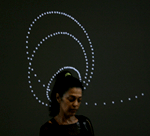
CHOREOGRAPHISMS
X-MOTION
CHOREOGRAPHISMS
concepts user interface ESDI project
UNSQUARE DANCE
RELATED WORK
PUBLICATIONS
PEOPLE
Context
Choreographisms is a multidisciplinary project that aims to combine techniques from Computer Graphics, Vision and Animation with applications in Contemporary Dance, Stage Design and Art.
In recent years, the use of multimedia resources, such as live projection and dynamic lighting, has been increasingly exploited in music shows, dance presentations and art performances. However, up to now, these powerful visual sources have been applied mostly as an additional element to the set background, thus transforming it into a visually dynamic stage.
Our goal in this project is to push forward the state-of-the-art by calling into the scene real-time interaction and vision techniques. In this way, by integrating motion capture with procedural graphics and live displays, we expand the creative possibilities enabling graphical elements to be used, not as a mere passive set element, but primarily as an active one – a virtual agent capable of interacting with other actors in the scene under the guidance of the director-choreographer.
Project
The above context frames the proposed project. For that, we developed the X–Motion system which enables the design of a virtual dynamic stage that is directly linked to the dance. The system uses movements of dancers as an input for the generation of graphisms that are projected on the set in real-time. In this manner, the choreographer directs not only the dancers’ movements, but also graphical elements that are projected into the set, which becomes dynamic and interactive. Thus, these graphisms act as virtual dancers, establishing an interaction and dialogue with real dancers mediated by the choreographer. They can be modified by interactions with the dancers, instigating changes to the dancers’ movements as well.
Dance / Movement
The contemporary body is more and more dependent on this exchange with the environment, in order to relate ideas.Thus, it is only natural that issues as such, representing an aesthetic counterpart of tecnological evolution, are embedded in the contemporary dance scene, which is therefore capable of absorbing onstage a system like the X-motion. Considering that the most striking characteristic of contemporary dance is diversity, the crucial point here was to determine the elements to be used in order to establish the link between both languages – bodily and pictorial. They needed to be representative enough, so the system could comprehend the entire universe of a contemporary presentation. The solution was to use basic form elements and the most elementary components the constitute dance.
Undoubtedly, the most intrinsic characteristic of dance as art is bodily movement. This is the only element one can find on all possibilities of choreographic composition in the contemporary scene. Motion onstage is, in itself, the most precise and true description of choreographic intention and creation; it embodies the sum of the qualities of movement, as determined by the choreographer, with the dancer’s execution, which also conforms to his/her interpretation and improvisation. The trajectory described by motion onstage, then, can be understood as representative of dance’s most essential space-temporal aspects. Therefore, to be based on the movement’s trajectory for the generation of the graphisms seemed as the adequate solution for this project. When capturing the movement of key points in the dancer’s body, the system computes position, velocity, curvature, and tangents of these motion-paths that are represented as curves parametrized in time. In this way, trajectories of tracked points become the system’s central mathematical abstraction.
Graphics Interpretation
Expressive visuals result from applying syntactic and semantic graphics rules to motion paths translating them into active shapes. In sum, the system correlates – not necessarily in the literal sense – basic spatial structures to the elementary components of dance. In this way, authorship is based on the graphic interpretation of the movement.
The choreographer’s role is to specify a set of formal attributes that demarcate a space of visual possibilities for the generation of graphisms, both in terms appearance (brush type, granularity, interpolation) and behavior (persistence, sinchronicity, animation, and projection). Most formal attributes allow for the determination of absolute values, therefore establishing a single visual aspect, or the choice between a maximum and minimum value, which turns that attribute into a variable, or a numeric interval in which values can change.